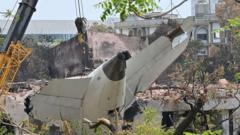The CVR is crucial for reconstructing events leading up to the crash, as it records cockpit audio, including conversations between pilots and crucial alarm notifications. Previously, the flight data recorder (FDR) had also been recovered, creating what is widely referred to as the "black box," essential for thorough investigation of air incidents. Interestingly, despite the name, the black boxes are actually bright orange, designed with reflective strips for easy identification post-crash.
India's Aircraft Accident Investigation Bureau (AAIB) is heading the investigation, with support from both U.S. and U.K. officials. A delegation from the U.S. National Transportation Safety Board (NTSB) has already examined the crash site. Concurrently, the Indian government has initiated a high-level panel destined to put together a preliminary report in three months, aimed at establishing new safety protocols to avert similar tragedies in the future.
Details are emerging that after its ascent, the Air India flight AI171 struck a residents’ building at BJ Medical College, leading to a high casualty count; only one aboard survived. Simultaneously, authorities are diligently working on the identification of deceased passengers and crew members, while DNA analysis has confirmed the identities of over 90 victims, including former Gujarat chief minister Vijay Rupani.
As families mourn their losses, the process of matching DNA samples has proven to be a slow and meticulous task, especially since many of the bodies were severely burned in the incident. The painful waiting period lingers for many relatives, like Mistry Jignesh, who fears the ongoing search efforts may delay the provision of his missing niece's remains.
With the investigation still ongoing, hope remains that vital findings will surface to clarify the circumstances surrounding this devastating air disaster.
India's Aircraft Accident Investigation Bureau (AAIB) is heading the investigation, with support from both U.S. and U.K. officials. A delegation from the U.S. National Transportation Safety Board (NTSB) has already examined the crash site. Concurrently, the Indian government has initiated a high-level panel destined to put together a preliminary report in three months, aimed at establishing new safety protocols to avert similar tragedies in the future.
Details are emerging that after its ascent, the Air India flight AI171 struck a residents’ building at BJ Medical College, leading to a high casualty count; only one aboard survived. Simultaneously, authorities are diligently working on the identification of deceased passengers and crew members, while DNA analysis has confirmed the identities of over 90 victims, including former Gujarat chief minister Vijay Rupani.
As families mourn their losses, the process of matching DNA samples has proven to be a slow and meticulous task, especially since many of the bodies were severely burned in the incident. The painful waiting period lingers for many relatives, like Mistry Jignesh, who fears the ongoing search efforts may delay the provision of his missing niece's remains.
With the investigation still ongoing, hope remains that vital findings will surface to clarify the circumstances surrounding this devastating air disaster.



















